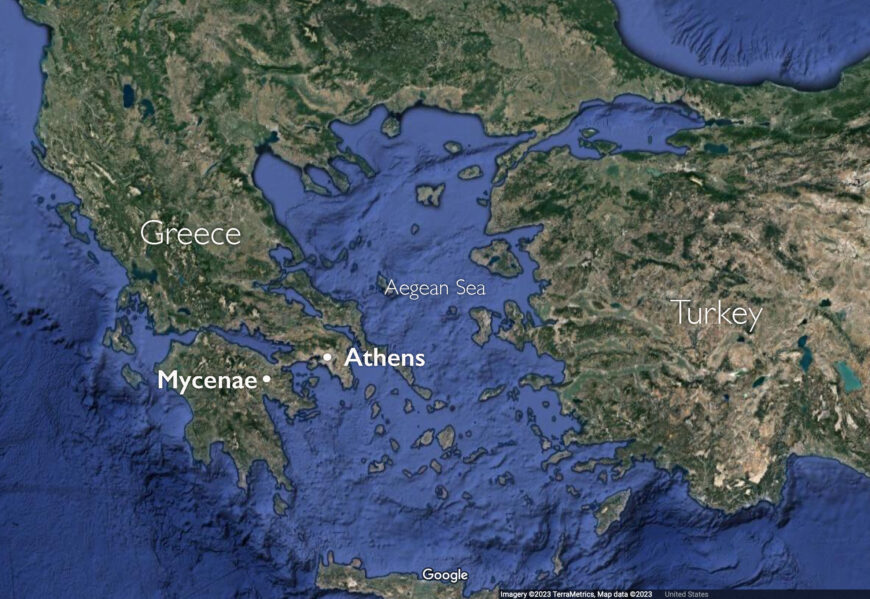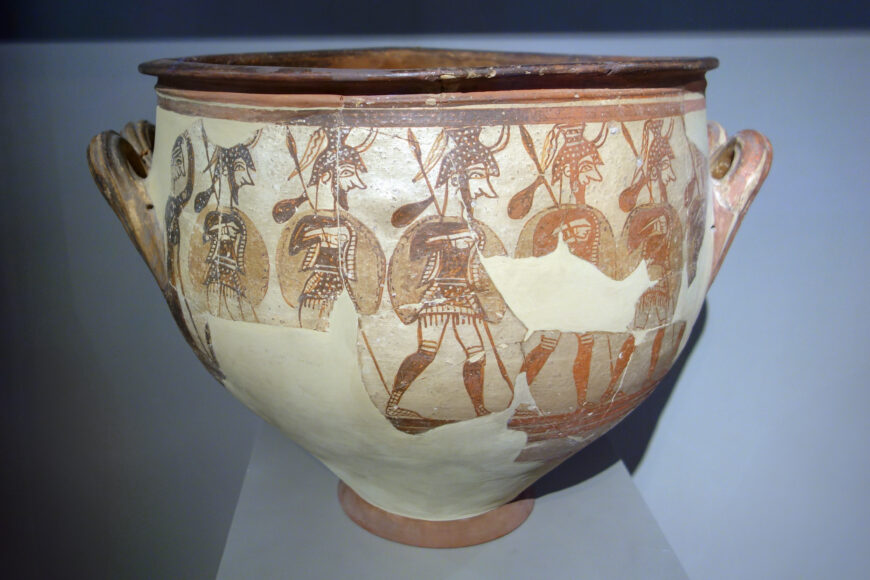
Front of Warrior Krater, c. 1200–1100 B.C.E., ceramic, 42 cm high (National Archaeological Museum, Athens; photo: Steven Zucker, CC BY-NC-SA 2.0)
One of the most famous vases from the ancient Mediterranean is decorated with a row of soldiers who march confidently across its surface. The vessel was made by a talented artist working in the city of Mycenae, in Greece, sometime between 1200 and 1100 B.C.E. Although Mycenaean civilization was in turmoil during this century, the artist who created this functional vessel decorated it elaborately with a militaristic theme that would have carried significance for its original owners. In the following paragraphs, we will explore the form, function, and find spot of the so-called Warrior Krater to better understand what it tells us about the Mycenaeans who used it three millennia ago.
Form and function
This vase is now known as the Warrior Krater because of its decoration and shape. Warriors are painted on both sides of the vessel. The specific shape of the vase makes it a krater. It has a wide opening at its top, low handles on both of its sides, and a narrow, ring-shaped base. In the ancient Greek world, people used kraters to mix wine and water. They believed it was appropriate to dilute their wine before drinking it. The Warrior Krater was discovered in a house in the ancient city of Mycenae. [1] The residents of this house might have used the vase to mix wine and water at banquets they hosted in their home, setting it out so that their guests could admire its decoration. [2]
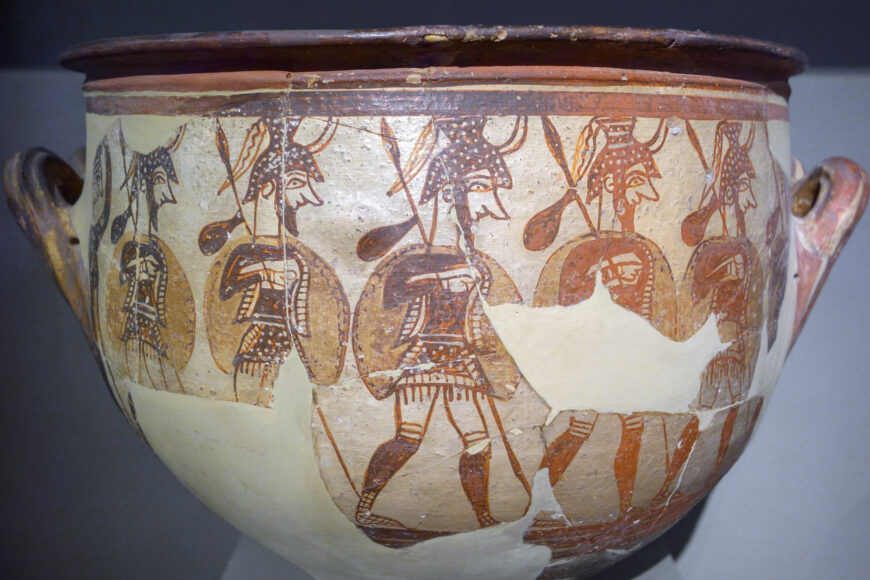
Soldiers on front of Warrior Krater (detail), c. 1200–1100 B.C.E., ceramic, 42 cm high (National Archaeological Museum, Athens; photo: Steven Zucker, CC BY-NC-SA 2.0)
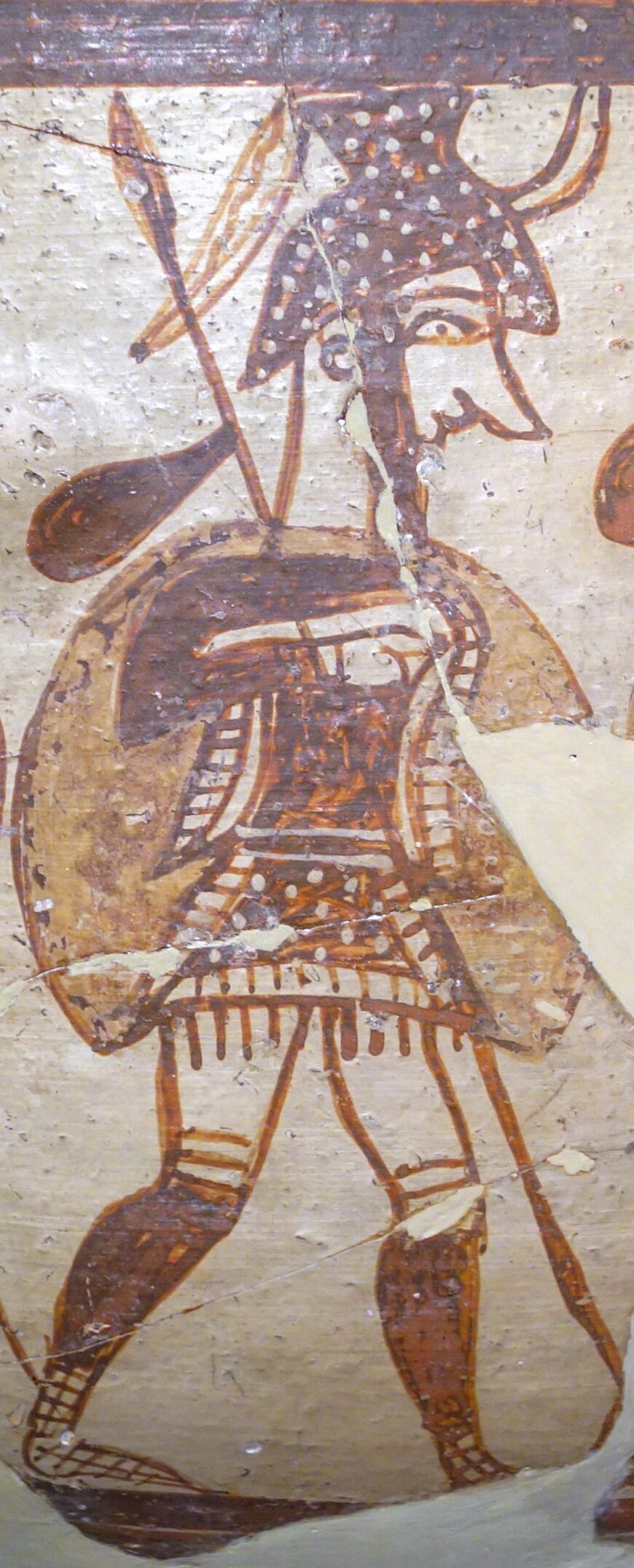
Soldier on front of Warrior Krater (detail), c. 1200–1100 B.C.E., ceramic (National Archaeological Museum, Athens; photo: Steven Zucker, CC BY-NC-SA 2.0)
Technique
Although the Warrior Krater was found in fragments, we can still see much of what the Mycenaean banqueters saw on its front side. The artist has used a polychrome technique to paint the ceramic vessel. This means that its figures are rendered in several different colors, including dark reddish-brown, yellow, and white. [3] The figures’ skin is left unpainted, and so is the same grayish color as the clay surface of the vessel. The warriors are evenly spaced and all walk across the same groundline. Although we might first see these warriors as being almost cartoonish in their simplicity, this simplicity is intentional: it allows them to be easily recognized as soldiers, even today, long after they were first painted. [4] Moreover, looking more closely at these warriors reveals that the artist has actually painted them with meticulous detail.
A story about soldiers
Each of the six soldiers on the front of the vessel wears a similar costume. The best preserved of the soldiers is the third from the left. On his head, he wears an elaborate helmet with a central protrusion at the top. A feather extends from the back of the helmet, while a horn protrudes from its front. The soldier’s face is simple yet easily understandable. He has a clearly delineated ear, an eye with a pupil, an arching eyebrow, a prominent nose, and a small mouth. The brown pigment that decorates his chin represents his beard. [5] Like his companions, he wears a protective long-sleeve shirt, a short fringed skirt, lower-leg protectors (known as greaves), and boots indicated by cross-hatching on his feet. He carries additional battle equipment. In his right hand, which is positioned in front of his chest, he holds a tall spear pointing upwards. The small brown bag that hangs from his spear might contain his rations. [6] Although the soldier’s left arm is not clearly visible, we see the outline of the object he holds behind him. The round, yellowish shape that appears behind his torso represents the metal shield he carries in his left hand. [7]
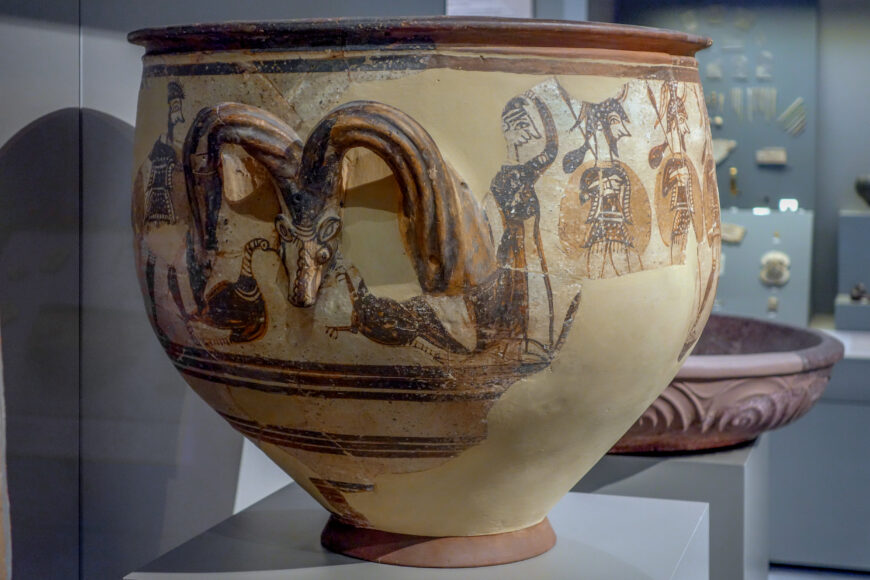
Left side with handle and woman (detail), Warrior Krater, c. 1200–1100 B.C.E., ceramic, 42 cm high (National Archaeological Museum, Athens; photo: Steven Zucker, CC BY-NC-SA 2.0)
The soldiers appear to walk in sync towards the other side of the vessel, each extending their left leg. The repetition of the soldiers adds a sense of rhythm to the image, recalling the synchronized march of a procession of real soldiers. Behind these warriors, just in front of one of the vessel’s handles, stands a woman. Although her face closely resembles the faces of the soldiers in front of her, her costume distinguishes her as female. She wears a long dress and a cap (which we see only part of because of the incomplete preservation of the krater). She raises her left hand to her head in a gesture that indicates mourning or farewell. [8] This woman may be waving goodbye to the soldiers who are marching away from her, and perhaps simultaneously grieving the potentially deadly fate they will face on the battlefield.
Just behind this female figure, we can see one of the Warrior Krater’s elaborate handles. The handle has two twisting arches that meet in the center. The central portion of the handle is decorated with a bull’s head: it is almost as if we are meant to understand the twisting handles as exaggerated horns that emerge from the bull’s head. [9] Bulls were highly valued, both as animals that could assist with everyday tasks required of farming, and as particularly rich gifts that could be sacrificed to the gods. Beneath each of the handle’s arches is a goose-like bird with a striped neck. Neither the birds nor the bull seem to be part of the military scene on the vase. Instead, they may have been included simply to add more decoration.
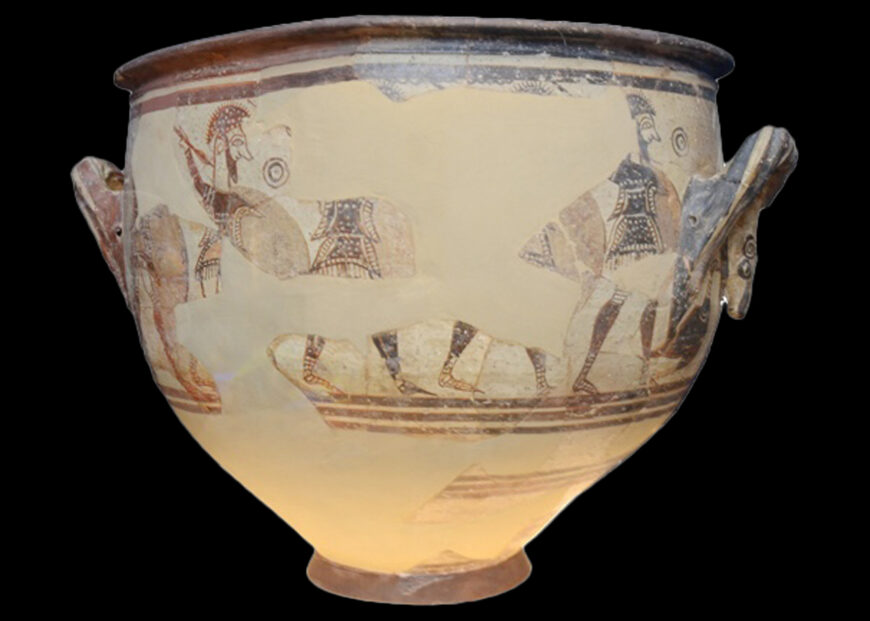
Back of Warrior Krater, c. 1200–1100 B.C.E., ceramic, 42 cm high (National Archaeological Museum, Athens)
The back of the Warrior Krater is much more poorly preserved than the front. It is decorated with five soldiers marching towards the right, in the same direction as the soldiers on the front of the vase. In many ways these soldiers closely resemble those on the front of the vase, but a few key details distinguish them. The soldiers on the back of the vase wear a different kind of helmet, characterized by a series of pointy protrusions. They also hold their spears and shields differently. Their shields are lowered in front of them, and their spears are pointing forwards. These soldiers are ready to attack. [10]
Interpreting the narrative
It is possible that ancient viewers understood the front and back of the Warrior Krater to represent a single narrative. Perhaps the same group of soldiers is shown at two different stages of their deployment. On the front, they are leaving home as a woman watches their departure. On the back, they have reached the battlefield and are preparing to attack their enemies. [11] Perhaps we are meant to see two different groups of soldiers who are approaching one another and will soon meet to battle each other. [12] The exact interpretation of the vase’s story remains somewhat unclear. However, there is little doubt that the elaborate decoration would appeal to its Mycenaean viewers. Mycenae and its neighbors were often at war with one another. The level of strife in the Mycenaean civilization increased after 1200 B.C.E., as economic collapse and warfare spread throughout the region. [13] While enjoying a feast at a house in the city, Mycenaeans may have gazed upon this vase and been reminded of their many friends and relatives who had departed for battle, similarly dressed and similarly eager to defend their territory.
Pictorial style
We may be left wondering how it is possible that a Mycenaean artist was able to create such an elaborate vessel despite his tumultuous historical circumstances. The Warrior Krater is not the only Mycenaean vase decorated with people. Instead, it is one of many examples in a long-standing Mycenaean tradition of decorated pottery. From about 1400 B.C.E. onwards, Mycenaean craftspeople decorated some of their vases with human and animal figures. Today, these vessels are sometimes called Pictorial style vases. Pictorial style vases were made in mainland Greece, and many were exported to customers in Cyprus and other regions to the east. [14] The Warrior Krater is an especially late (and especially well-preserved) Pictorial style vase, and was surely made by an artist who was familiar with other Pictorial style vases.
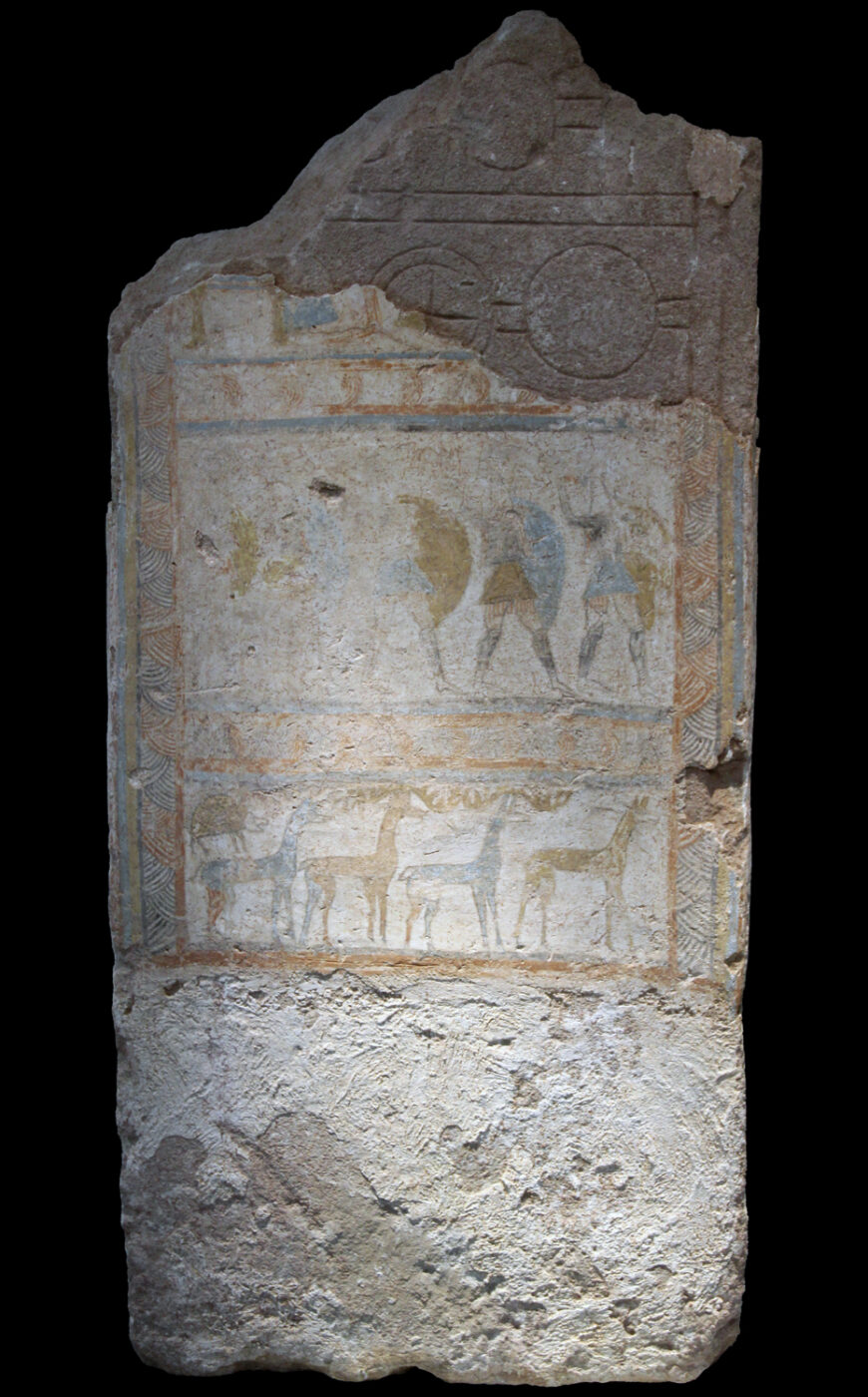
Painted Stele, painted decoration c. 1200–1100 B.C.E., stone covered in plaster and paint, 91 cm high (National Archaeological Museum, Athens; photo: CC0 1.0)
An adaptable artist
Although we do not know the name of the artist who made the Warrior Krater, we do have another example of his work. This artifact is a stele, or an upright carved stone slab. It was found in a tomb near Mycenae. [15] The middle register of the stele shows a row of five warriors that so closely resemble the warriors on the Warrior Krater that scholars have concluded they were made by the same person. [16] The warriors on the stele are now faded, but like their counterparts on the krater, they carry shields and spears. They wear stiff long-sleeve shirts, short skirts, leg protectors, and cross-hatched boots. They are much more vibrantly colored than the warriors on the krater, showing off a new aspect of the artist’s talent. It is possible that this artist—who is sometimes called the Stele Painter by modern scholars—was trained in both vase painting and fresco painting.
However, it is also possible that Mycenaean craftspeople working during the difficult period of 1200–1100 B.C.E. were adapting to make many different kinds of artworks. As resources in Mycenae dwindled, commissions for luxury items like large wall paintings and expensive metal goods would have decreased. [17] Artists like the one who made the Warrior Krater and the Painted Stele would have needed to craft smaller objects made of less expensive materials to make money. Despite its relatively inexpensive material, the Warrior Krater is an innovative work that reveals the talent of its creator and the interests of its original owners.

